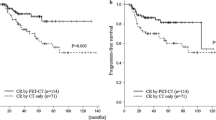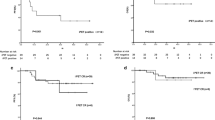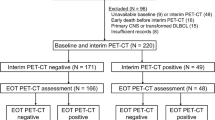Abstract
Treating patients with DLBCL remains a challenge, as the response to first-line immunochemotherapy is somewhat unpredictable. The International Prognostic Index (IPI) is one of the most widely used methods for assessing prognosis. Interim PET/CT (iPET/CT) can play an important role in the early identification of ‘non-responder’ patients before the end of treatment examination. In this study, we retrospectively analyzed 104 newly diagnosed DLBCL patients treated with R-CHOP-like regimens who underwent iPET/CT imaging during therapy. There was a significant difference in 2-year OS between patients with negative iPET/CT and those with positive iPET/CT. Patients who had positive iPET/CT showed inferior 2-year PFS compared to those with negative iPET/CT. According to IPI, there was a statistically significant difference in 2-year OS and PFS between patients in the lower and higher risk groups. However, these patients can be further subdivided according to iPET/CT. The iPET/CT results in the present study clearly separate good- and poor-prognosis patients according to differences in 2-year OS, both in the lower and higher IPI risk groups. These results are in agreement with those of previous studies that demonstrated that iPET/CT has high negative predictive value, clearly identifying good-prognosis patients even within the poor-prognosis IPI group.



Similar content being viewed by others
References
Sabattini E, Bacci F, Sagramoso C, Pileri SA. WHO classification of tumours of haematopoietic and lymphoid tissues in 2008: an overview. Pathologica. 2010;102:83–7.
Coiffier B, Thieblemont C, Van Den Neste E, Lepeu G, Plantier I, Castaigne S, et al. Long-term outcome of patients in the LNH-98.5 trial, the first randomized study comparing rituximab-CHOP to standard CHOP chemotherapy in DLBCL patients: a study by the Groupe d’Etudes des Lymphomes de l’Adulte. Blood. 2010;116:2040–5.
Gisselbrecht C, Glass B, Mounier N, Singh Gill D, Linch DC, Trneny M, et al. Salvage regimens with autologous transplantation for relapsed large B-cell lymphoma in the rituximab era. J Clin Oncol. 2010;28:4184–90.
Sehn LH, Berry B, Chhanabhai M, Fitzgerald C, Gill K, Hoskins P, et al. The revised international prognostic index (R-IPI) is a better predictor of outcome than the standard IPI for patients with diffuse large B-cell lymphoma treated with R-CHOP. Blood. 2007;109:1857–61.
Alizadeh AA, Eisen MB, Davis RE, Ma C, Lossos IS, Rosenwald A, et al. Distinct types of diffuse large B-cell lymphoma identified by gene expression profiling. Nature. 2003;403:503–11.
Hans CP, Weisenburger DD, Greiner TC, Gascoyne RD, Delabie J, Ott G, et al. Confirmation of the molecular classification of diffuse large B-cell lymphoma by immunohistochemistry using a tissue microarray. Blood. 2004;103:275–82.
Rosenwald A, Wright G, Chan WC, Connors JM, Campo E, Fisher RI, et al. The use of molecular profiling to predict survival after chemotherapy for diffuse large-B-cell lymphoma. N Engl J Med. 2002;346:1937–47.
Lenz G, Staudt LM. Aggressive lymphomas. N Engl J Med. 2010;362:1417–29.
Ilić I, Mitrović Z, Aurer I, Basic-Kinda S, Radman I, Ajdukovic R, et al. Lack of prognostic significance of the germinal-center phenotype in diffuse large B-cell lymphoma patients treated with CHOP-like chemotherapy with and without rituximab. Int J Hematol. 2009;90:74–80.
Barrington SF, Mikhaeel NG, Kostakoglu L, Meignan M, Hutchings M, Müeller SP, et al. Role of imaging in the staging and response assessment of lymphoma: consensus of the international conference on malignant lymphomas imaging working group. J Clin Oncol. 2014;32:3048–58.
Cheson BD, Fisher RI, Barrington SF, Cavalli F, Schwartz LH, Zucca E, et al. Recommendations for Initial evaluation, staging, and response assessment of hodgkin and non-hodgkin lymphoma: the Lugano Classification. J Clin Oncol. 2014;32:3059–67.
Thomas A, Gingrich RD, Smith BJ, Jacobus L, Ristow K, Allmer C, et al. 18-Fluoro-deoxyglucose positron emission tomography report interpretation as predictor of outcome in diffuse large B-cell lymphoma including analysis of ‘indeterminate’ reports. Leuk Lymph. 2010;51:439–46.
Vitolo U, Chiappella A, Bellò M, Passera R, Botto B, Castellano G, et al. The outcome of patients with diffuse large B-Cell lymphoma (DLBCL) treated with Rituximab-CHOP (R-CHOP) is not predicted by 18-FDG-Positron Emission Tomography/Computerized Tomography (PET) performed at intermediate in-course evaluation, but only by PET assessed at the end of therapy. Blood. 2010;116:2819.
Meignan M, Gallamini A, Meignan M, Gallamini A, Haioun C. Report on the first international workshop on interim-PET-scan in lymphoma. Leuk Lymph. 2009;50:1257–60.
Chow A, Phillips M, Siew T, Cull G, Augustson B, Ward M, et al. Prognostic nomogram for diffuse large B-cell lymphoma incorporating the International Prognostic Index with interim-positron emission tomography findings. Intern Med J. 2013;43:932–9.
Nols N, Mounier N, Bouazza S, Lhommel R, Costantini S, Vander Borght T, et al. Quantitative and qualitative analysis of metabolic response at interim positron emission tomography scan combined with International Prognostic Index is highly predictive of outcome in diffuse large B-cell lymphoma. Leuk Lymph. 2013;55:773–80.
Jiang M, Chen P, Ruan X, Ye X, Pan Y, Zhang J, et al. Interim 18F-FDG PET/CT improves the prognostic value of S-IPI, R-IPI and NCCN-IPI in patients with diffuse large B-cell lymphoma. Oncol Lett. 2017;14:6715–23.
Mikhaeel NG, Smith D, Dunn JT, Phillips M, Møller H, Fields PA, et al. Combination of baseline metabolic tumour volume and early response on PET/CT improves progression-free survival prediction in DLBCL. Eur J Nucl Med Mol Imaging. 2016;43:1209–19.
Safar V, Dupuis J, Itti E, Jardin F, Fruchart C, Bardet S, et al. Interim [18F]fluorodeoxyglucose positron emission tomography scan in diffuse large B-cell lymphoma treated with anthracycline-based chemotherapy plus rituximab. J Clin Oncol. 2012;30:184–90.
Zhang Y, Fan Y, Ying Z, Song Y, Zhu J, Yang Z, et al. Can the SUV max-liver -based interpretation improve prognostic accuracy of interim and posttreatment 18 F-FDG PET/CT in patients with diffuse large B-cell lymphoma? Leuk Lymph. 2018;59:660–9.
Han EJOH, Yoon H, Jung SE, Park G, Choi BO, et al. FDG PET/CT response in diffuse large B-cell lymphoma: reader variability and association with clinical outcome. Medicine (Baltimore). 2016;95:e4983.
Kim J, Song YS, Lee JS, Lee WW, Kim SE, et al. Risk stratification of diffuse large B-cell lymphoma with interim PET-CT based on different cutoff Deauville scores. Leuk Lymphoma. 2018;59:340–7.
Pregno P, Chiappella A, Bellò M, Botto B, Ferrero S, Franceschetti S, et al. Interim 18-FDG-PET/CT failed to predict the outcome in diffuse large B-cell lymphoma patients treated at the diagnosis with rituximab-CHOP. Blood. 2012;119:2066–73.
de Oliveira Costa R, Neto HA, Siqueira S, de Lage LAPC, de Paula HM, Coutinhoet AM, et al. Interim fluorine-18 fluorodeoxyglucose PET-computed tomography and cell of origin by immunohistochemistry predicts progression-free and overall survival in diffuse large B-cell lymphoma patients in the rituximab era. Nucl Med Commun. 2016;37:1095–101.
Kim J, Lee JO, Paik JH, Lee WW, Kim SE, Song YS, et al. Different predictive values of interim (18)F-FDG PET/CT in germinal center like and non-germinal center like diffuse large B-cell lymphoma. Ann Nucl Med. 2017;31:1–11.
Jiang M, Chen P, Ruan X, Xu W, Li T, Wu L, et al. Interim 18F-FDG PET/CT and BCL2 for predicting the prognosis of patients with diffuse large B-cell lymphoma in the rituximab era. Nucl Med Commun. 2018;39:147–53.
Spaepen K, Stroobants S, Dupont P, Bormans G, Balzarini J, Verhoef G, et al. [(18)F]FDG PET monitoring of tumour response to chemotherapy: does [(18)F]FDG uptake correlate with the viable tumour cell fraction? Eur J Nucl Med Mol Imaging. 2003;30:682–8.
Kasamon YL, Jones RJ, Wahl RL. Integrating PET and PET/CT into the risk-adapted therapy of lymphoma. J Nucl Med. 2007;48:19S–27S.
Baratto L, Davidzon GA, Moghbel M, Hatami N, Iagaru A, Mittra ES, et al. Comparison between different PET and CT-based imaging interpretation criteria at interim imaging in patients with diffuse large B-Cell lymphoma. Clin Nucl Med. 2018;43:1–8.
Author information
Authors and Affiliations
Corresponding author
Ethics declarations
Conflict of interest
The authors declare that they have no conflict of interest.
Additional information
Publisher's Note
Springer Nature remains neutral with regard to jurisdictional claims in published maps and institutional affiliations.
About this article
Cite this article
Nyilas, R., Farkas, B., Bicsko, R.R. et al. Interim PET/CT in diffuse large B-cell lymphoma may facilitate identification of good-prognosis patients among IPI-stratified patients. Int J Hematol 110, 331–339 (2019). https://doi.org/10.1007/s12185-019-02690-2
Received:
Revised:
Accepted:
Published:
Issue Date:
DOI: https://doi.org/10.1007/s12185-019-02690-2




